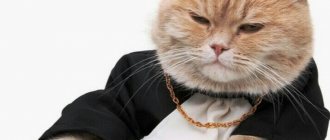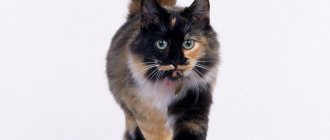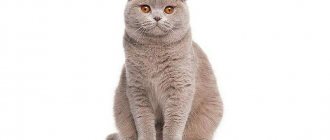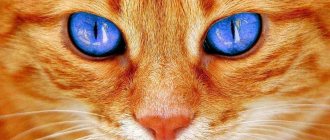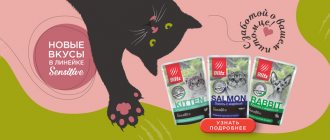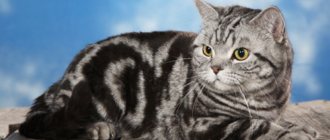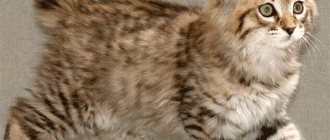Cats of the English breed are characterized by solid colors. Most often you can find British gray-blue shades. But even a black cat doesn’t look like a “black sheep” against their background. His thick and evenly colored coat looks very impressive.
Let's find out whether there are any peculiarities in the breeding and character of black cats, as well as what signs are associated with these animals.
British black standard
Felinologists say that breeding Black Britons is a complex genetic puzzle. At exhibitions, strict requirements are imposed on color, since it is this indicator that indicates the purity of the animal’s breed.
- The coat should be dense, thick, soft and short. Increasing the hair length will result in disqualification. Previously, long-haired cats were in the same group as short-haired cats. But experts decided that in this way they were spoiling the breed and culled all animals that did not fit the general standard. Then another variety of British cats appeared, which differ in hair length from the traditional representatives of the breed.
- Each hair is evenly colored along its entire length - from the root bulb to the tip. It is not allowed to lighten any of the parts or have areas on the coat interspersed with foreign color. The requirement applies only to solid colors.
- The thick, dense undercoat should not differ from the main color in color and tone.
In addition to coat color, Black Britons differ from other representatives of their breed in several other characteristics.
These cats should have orange-honey or golden eyes. Green eye color, traditional for this cat breed, in combination with black fur, is considered a fault. Such animals do not receive championship awards and do not take part in breeding.
The nose and paw pads should be painted the main color (black). Charcoal-anthracite cats, completely authentic to the British breed, are often shown at exhibitions, but the pigmentation of the skin “let down” such mestizos.
Sometimes residual properties of the tabby pattern still appear on the black coat of young British cats. This is expressed in the absence of shine in certain areas or a subtle change in color. But by puberty, such signs usually disappear.
This is interesting! The quality of the coat of black British cats is slightly different from other colors of this breed. It is more rigid, with a characteristic glossy shine.
Exterior
Black British men have a strong, massive body with a straight back. The legs are short, the chest is wide. The body is of medium size, not elongated.
Other exterior features are described in the table:
| Part of the body | Description |
| Head | Round, with full cheeks, wide cheekbones and a thick neck. |
| Muzzle | Round, with clear whisker pads. |
| Nose | Straight, wide, short. The profile has a slight recess. The color of the nose corresponds to the color. |
| Chin | Well developed, strong. The lower part of the chin and the tip of the nose form a vertical line. |
| Neck | Short, massive, with a thick fold that only the British have. |
| Ears | Small, widely set, rounded tips. The outside is densely covered with hair, the inside is slightly drooping. |
| Eyes | Round, large, bright, rich color - orange, golden or copper. Kittens may have a blue tint to their eyes, but this disappears by 3-4 months. |
| Paws | Short, thick. There are 5 toes on the front ones, 4 on the back ones. The color of the pads corresponds to the color or charcoal. |
| Tail | Thick, medium, cone-shaped, wide at the base, with a rounded tip. |
The coat can be long or short (plush), with a good undercoat. In the first case, pets have fluffy “pants.” The coat should be black to the very roots. The color of the undercoat is to blend with the main tone. The weight of males is from 5 to 8 kg, females - 3-5 kg. The British live up to 15 years.
Color genetics of the British breed
The genetics of the color of black British cats involves a large number of components. These include pigments, genes, loci, alleles and chromosomes.
- Only eumelanin (a group of melanins with an irregular structure and complex chemical composition) takes part in the formation of color in black British cats.
- Genes carry information about an individual trait with the corresponding hereditary instructions.
- Loci determine the location of a gene in the chromosomal map.
- Alleles are represented as different variants of the same gene.
- Any cat has 38 chromosomes, 19 elements from each of the parents, in which all the parameters of unborn kittens are encrypted.
The B gene is responsible for black color. In various combinations of alleles, it takes the form bb (chocolate) and blbl (cinnamon, cinnamon). But for black cats (British or any other) only the dominant species B is required.
The second hereditary trait is the D gene, which is responsible for lightening any color.
- Option dd characterizes the transformation of color as a whole - any color is lightened (black turns into blue, red becomes cream, and chocolate cats get a purple coat).
- The combination dmdm gives silver ends to the hair, and Dm together with dd gives a caramel shade.
In black British cats, the D gene must dominate. Otherwise, the animal's coat will be any other color, but not charcoal.
The C gene is responsible for the formation of solid color. In other alleles, it appears in the combinations cscs (Siamese), cbcb (Burmese), caca (blue-eyed albinos). But in its dominant form, C causes the eumelanin pigment to evenly color the entire length of the hair. In combination with B and D we are talking about deep black color.
A pair of cats, each with the BBDD gene set, is guaranteed to produce black British kittens. They cannot have any other color in their litter.
This is interesting! Other combinations of alleles that transform dominant genes into a recessive state (b and d) suggest the presence of chocolate, blue-gray and lilac colors in young animals. With such parents, it is impossible to guess what the kitten will be like.
How to choose a Black British kitten
To choose a black kitten, it is best to seek help from experienced breeders or those who already have similar animals. Otherwise, you need to rely only on your knowledge. First of all, you need to understand that the final color of British cats is formed with age. In childhood, babies are all dark, they have small ears and wide open eyes. If the “children” have purebred and “coal” parents, then you can try your luck and buy a “child”, in the hope that the shade of the fur coat will not change with age.
Don't go for cheap
Many people, wanting to buy a black cat, start saving. This circumstance plays into the hands of dishonest sellers who, under the pretext of a discount, sell animals a little cheaper, but at the same time, making a good profit for them. As a result, it turns out that the “coal” kittens lost their shade by six months, and only the name remained from the British. You should buy purebred fluffies exclusively from trusted people, whose names are well-known to many. In this case, sellers must show all documents for the parents.
Important! Black British cats are expensive. This is due to the complexity of breeding the breed, so there can be no talk of any price reduction in this case.
Read the breed standard
To avoid mistakes, you need to know the breed standard. The British have many distinctive features that you need to know. The main ones are that the eye color changes only by three to four months, and the shade of the coat, which will remain forever, can be observed only by six months. Therefore, it is worth buying an animal either at this age or earlier, hoping for a miracle.
Difficulties in breeding black British cats
The antiquity of the breed is both a plus and a minus for the British Shorthair. On the one hand, a long pedigree benefited immunity, adaptation to external living conditions and a stable phenotype (the totality of all the characteristics of the animal).
On the other hand, in the process of improving the British breed, breeders had to face problems in the field of genetics and cat breeding. About 100 years ago, breeders began working on fixing the classic blue-gray color. Later they focused their efforts on creating new shades.
As a result, the population acquired two hundred colors, among which black was lost. No one deliberately studied within the entire breed in order to obtain a separate group capable of reproducing in this range.
The black British cat has received local development only in some nurseries. But here too, breeders are faced with the problem of inbreeding. There are too few animals suitable for breeding, many of them are consanguineous, so the risk of uncontrolled mutation increases.
For this reason, there is an exchange of breeding sires from different geographical regions. This is how breeders renew the breed and maintain it in its purest form.
This is interesting! Sometimes nature plays jokes even on cats with ideal genetic parameters. The coat color of kittens that are born light-colored may change to black as they age. Other options are also possible - the standard shiny charcoal color suddenly fails and completely fades, or spots of a different shade appear on the fur coat.
Contents of a Black Briton
Contrary to popular belief that the British are difficult to look after, the reality is completely different. If you follow simple rules of care, a four-legged animal can easily live up to 18, and sometimes 20 years.
General Content Rules
There are just a few nuances that you should pay attention to.
- Avoid hypothermia of animals and do not place their houses in drafts. Representatives of these breeds have weak eyes. Therefore, at the slightest breath of wind, their eyes begin to water and sour.
- Visit a veterinarian regularly, especially for owners of animals over 10 years old, and get vaccinated.
- Feed your cats correctly.
- Do not allow frequent matings (for cats), this weakens the immunity of fluffies, they begin to get sick often.
Feeding a British cat
Caring for cats involves proper feeding. This can be high-quality dry food or canned food, as well as natural food.
Important! It is strictly forbidden to combine drying with food from the table, because this will lead to serious problems with the gastrointestinal tract.
First you need to decide, and then carefully select your diet. If preference is given to dry food, then it is better to choose the holistic or super-premium lines. Many brands offer food specifically for the British, taking into account their age.
At the same time, veterinarians advise choosing food based on the four-legged lifestyle. If the animal is overweight, then it is worth purchasing appropriate food. If the cat does not leave the house, therefore, it is necessary to purchase appropriate food. It's all written on the packs. In addition, veterinarians working in specialized pet stores will always give advice and help, so this will not be a problem.
Some owners worry that their British black kitten will go hungry while they are at work. Therefore, they leave the drying directly in the bowl, pouring it with a mountain. This cannot be done because, firstly, the feline’s stomach will quickly stretch out, and secondly, they will get used to the fact that they can eat as much as they want, and then they will not leave their feeder. Considering that the British are prone to obesity, doing this is strictly prohibited.
As for natural nutrition, in this case it is better to give preference to fresh meat. It could be rabbit, veal or turkey. It is advisable to avoid pork as it is too fatty. Before serving, the treat can be doused with boiling water and given to the animal immediately. To make food more nutritious, it is recommended to use vegetables. It could be pumpkin, zucchini or carrots. Some people grind the meat in a meat grinder, then grind the vegetables and make vegetable-meat balls, which the four-legged animals eat with pleasure.
Features of British hair care
There are also some differences regarding the hygiene and living conditions of black British cats.
- British fur coat color can vary depending on diet. For example, food containing beets is suitable for dark-colored cats. But a large amount of seafood on a cat’s menu can negatively affect the color of the paws and nose - these areas of the body will become lighter, in contrast to the main shade.
- When exposed to ultraviolet light, a black cat's fur becomes dull and takes on a gray tint. To restore color, you will have to limit the time your pet stays in direct sunlight.
Despite the short hair, the British cat needs regular brushing during shedding. The procedure is carried out several times a day using a special mitten or comb.
Character of British pets
Representatives of the British breed belong to the category of pets with a difficult character.
- Sociable, but do not allow familiarity. You can pick up a British cat only if she is currently in the mood for it. Any violence or action against the will is regarded as an insult. The cat may proudly walk away, or it may bite.
- The Briton is not prone to active group games. He will most likely stay in a safe place and look down on all the fun.
- Very persistent in expressing their own demands. There are times when cats of this breed do not eat for a long time just because they want to change the place for their bowl.
There is a tendency towards aggression in the behavior of British Shorthairs. But it is never groundless. If the cat does not feel discomfort, then it will not terrorize the household with its bad inclinations.
Reviews
Some owner reviews:
- “I fell in love at first sight. Our Vaska is a very beautiful cat, and prone to narcissism. He can sit in front of the mirror for an hour and look at himself. There are no problems with him. Sometimes he confuses a scratching post with a sofa, and his toys with my books.”
- “When our son was born, we had to take Jason to his parents in the village. The cat constantly hissed at the baby, which did not stop him and the child continued to climb towards the cat. In the end, the inevitable happened - our son was scratched all over, and the cat moved away from us.”

